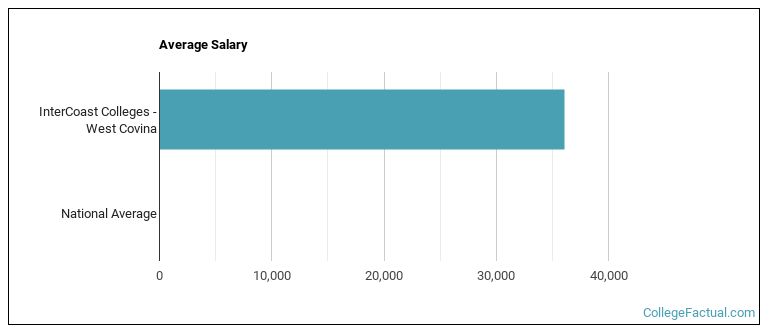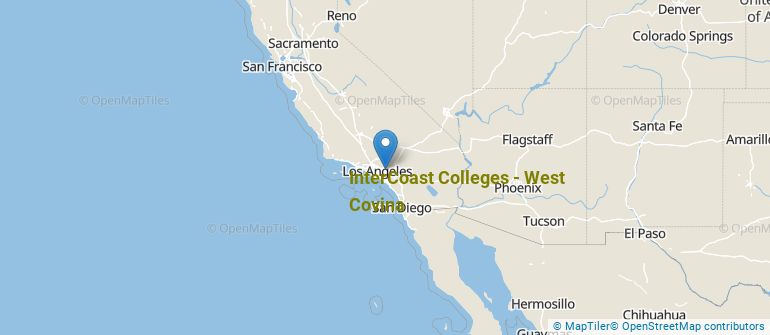 by our College Data Analytics Team
by our College Data Analytics TeamExplore the best ranked schools for the programs you are most interested in.
InterCoast Colleges - West Covina was not ranked in College Factual's Best Overall Colleges report this year. This may be because not enough data was available.
See all of the rankings for InterCoast Colleges - West Covina.
If you are worried about getting into InterCoast Colleges - West Covina, don't be. The school has a liberal open admissions policy, which means you only need to meet basic requirements in order to be admitted. Still, be sure to submit a complete application and provide any other requested materials.
With a student to faculty ratio of 15 to 1, InterCoast Colleges - West Covina is about average in this regard as the nationwide rate is 15 to 1. While this does not translate directly to class size, it's a good indicator of how much time professors will have to spend with their students on a one-on-one basis.
In addition to the student to faculty ratio, some people look at what percentage of faculty members are full-time as a sign of how much time professors will be able to spend with their students. This is because part-time teachers may not be be on campus as much as their full-time counterparts.
The full-time faculty percentage at InterCoast Colleges - West Covina is 14%. This is lower than the national average of 47%.
InterCoast Colleges - West Covina has a freshmen retention rate of 74%. That's a good sign that full-time students like the school and their professors enough to want to stick around for another year. It's also a sign that the admissions team did a good job in choosing applicants who were a good fit for the school.
During the 2017-2018 academic year, there were 468 full-time undergraduates at InterCoast Colleges - West Covina.
The net price is calculated by adding tuition, room, board and other costs and subtracting financial aid.Note that the net price is typically less than the published for a school. For more information on the sticker price of InterCoast Colleges - West Covina, see our tuition and fees and room and board pages.
Almost 66% of college students who graduated with the class of 2018 took out student loans, but that percentage varies from school to school. At InterCoast Colleges - West Covina, approximately 71% of students took out student loans averaging $5,865 a year. That adds up to $23,460 over four years for those students.
Get more details about paying for InterCoast Colleges - West Covina.

See which majors at InterCoast Colleges - West Covina make the most money.
Get more details about the location of InterCoast Colleges - West Covina.

Contact details for InterCoast Colleges - West Covina are given below.
| Contact Details | |
|---|---|
| Address: | 2235 East Garvey Ave. North, West Covina, CA 91791 |
| Phone: | 626-337-6800 |
| Website: | https://www.intercoast.edu/ |
| Most Popular Majors | Bachelor’s Degrees | Average Salary of Graduates |
|---|---|---|
| Mental & Social Health Services | 99 | NA |
| Electrical & Power Transmission Installers | 84 | NA |
| Heating, Air Conditioning, Ventilation & Refrigeration | 16 | NA |
| Business Support & Assistant Services | 12 | NA |
| Business Administration & Management | 2 | NA |
| Information Technology | 2 | NA |
| Accounting | 1 | NA |
| Health & Medical Administrative Services | 0 | NA |
Online learning options are becoming more and more popular at American colleges and universities. Online classes are great for students who have busy schedules or for those who just want to study on their own time.
In 2022-2023, 449 students took at least one online class at InterCoast Colleges - West Covina. This is an increase from the 62 students who took online classes the previous year.
| Year | Took at Least One Online Class | Took All Classes Online |
|---|---|---|
| 2022-2023 | 449 | 59 |
| 2021-2022 | 62 | 62 |
| 2020-2021 | 284 | 284 |
| 2018-2019 | 0 | 0 |
Learn more about online learning at InterCoast Colleges - West Covina.
Footnotes
*The racial-ethnic minorities count is calculated by taking the total number of students and subtracting white students, international students, and students whose race/ethnicity was unknown. This number is then divided by the total number of students at the school to obtain the racial-ethnic minorities percentage.
References
More about our data sources and methodologies.